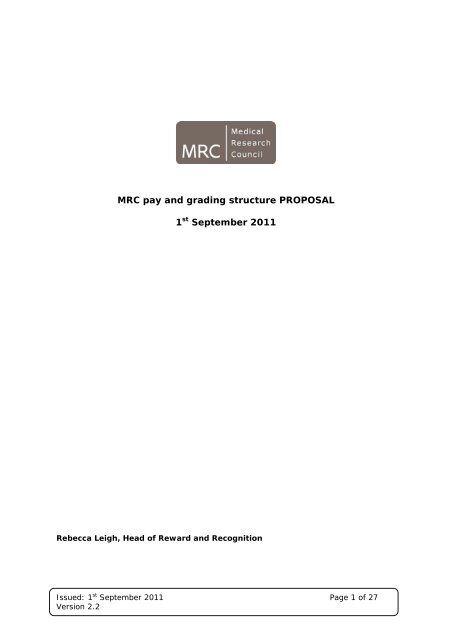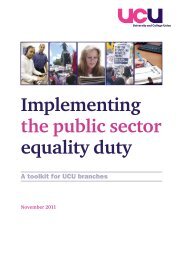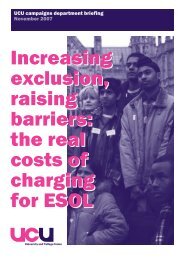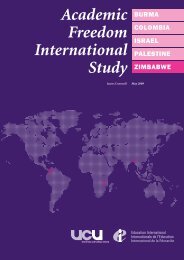MRC pay and grading structure - UCU
MRC pay and grading structure - UCU
MRC pay and grading structure - UCU
You also want an ePaper? Increase the reach of your titles
YUMPU automatically turns print PDFs into web optimized ePapers that Google loves.
Pay <strong>and</strong> <strong>grading</strong> proposalC. Principles of the new <strong>structure</strong>7. The new <strong>pay</strong> <strong>structure</strong>7.1 The new <strong>pay</strong> <strong>structure</strong> will consist of the 7 main b<strong>and</strong>s (b<strong>and</strong> 7 – b<strong>and</strong> 1). Inaddition there will be now be Senior Contract Pay which sits above b<strong>and</strong> 1 in thenew <strong>structure</strong>; further detail is provided later in the document.7.2 Each of these b<strong>and</strong>s (excluding Senior Contract Pay <strong>and</strong> b<strong>and</strong> 1) is split into 2sections: the A <strong>and</strong> B section of the b<strong>and</strong>.8. Starting salaries8.1 New starters are expected to start on the minimum point of the relevant A section ofthe <strong>pay</strong> b<strong>and</strong>.8.2 Where the new starter can provide evidence of working at the same level as jobthey are starting then a higher starting point can be given within the b<strong>and</strong> to reflectthe number of years the new starter has already been practicing at that level.8.3 It is expected that all employees will appointed in the first instance to the Adevelopmental section of the b<strong>and</strong> to allow for management assessment <strong>and</strong>advancement to the B section to take place in the future.8.4 For at least the first year of operation of the revised <strong>structure</strong>, authority to recruitdirectly into the B section of the b<strong>and</strong> will need to be obtained from Regional orCorporate HR, this is to ensure that decisions are being made consistently acrossthe <strong>MRC</strong>. Following this, Corporate HR will continue to need to be notified of anyintention to recruit directly into the B section of the b<strong>and</strong>.Future workThe governance <strong>and</strong> appropriate process for gaining authority to recruit into section Bwill be developed during implementation of the new <strong>structure</strong>.9. Career Development Fellows (CDF’s)9.1 Due to the specialist training nature of CDF posts separate <strong>pay</strong> <strong>and</strong> <strong>grading</strong>arrangements exist which are described later in this document.9.2 The arrangements fall within the scope of this <strong>pay</strong> <strong>structure</strong> but provide a more<strong>structure</strong>d <strong>and</strong> consistent approach to <strong>pay</strong> for this group of employees.10. Apprenticeships10.1 The basic principle of <strong>pay</strong> for apprenticeships is provided later in this document.11. B<strong>and</strong>s 1,2 <strong>and</strong> Senior Contract Pay11.1 The lack of a maximum in b<strong>and</strong> 2 has led to a wide range of salaries within the b<strong>and</strong><strong>and</strong> considerable overlap <strong>and</strong> confusion with the B<strong>and</strong> 1 category of staff which isdifficult to justify from an equalities <strong>and</strong> transparency perspective.Issued: 1 st September 2011 Page 5 of 27Version 2.2
Pay <strong>and</strong> <strong>grading</strong> proposal11.2 Work reviewing b<strong>and</strong> 2 is not new at the <strong>MRC</strong> <strong>and</strong> working groups have been set upin the past to try to resolve the issues within the b<strong>and</strong> 2 scale.11.3 Staff in B<strong>and</strong> 2 will be distributed between b<strong>and</strong> 2 <strong>and</strong> b<strong>and</strong> 1.11.4 Many of those currently in B<strong>and</strong> 1 will move onto Senior Contract Pay. SeniorContract Pay (SCP) will start at £100,000 upwards, this aligns with the BISgovernance requirements for those earning over £100,000.Future workFollowing agreement of the new <strong>structure</strong>, an exercise will be undertaken to providegreaterclarity on the use of the new b<strong>and</strong>s 2, 1 <strong>and</strong> SCP. This will involve furtherconsultation with key <strong>MRC</strong> stakeholders <strong>and</strong> external job evaluation sources.Issued: 1 st September 2011 Page 6 of 27Version 2.2
Pay <strong>and</strong> <strong>grading</strong> proposalD. Job evaluation12. Job evaluation <strong>and</strong> the new <strong>structure</strong>s12.1 Currently research support, technical <strong>and</strong> administrative roles are evaluated throughthe JEGS (Job Evaluation Grading Scheme) system of evaluation. Although scientificposts are not evaluated through JEGS, an initial evaluation took place of these rolesso that generic b<strong>and</strong> profiles are used for these roles.12.2 The backbone of the current <strong>structure</strong> is based in JEGS <strong>and</strong> this provides a degree ofassurance that the <strong>MRC</strong> b<strong>and</strong>s as they st<strong>and</strong> are based on a fair evaluation systemtherefore employees will not be evaluated upon mapping to the new <strong>structure</strong>.13. Research support, technical <strong>and</strong> administrative roles13.1 JEGS will continue to be used for research support, technical <strong>and</strong> administrativeroles in the new <strong>structure</strong>.Future workTo enable job evaluation to be run more smoothly a number of actions will beworked on through development of the project:Corporate HR will develop a library of JAF forms/job descriptions for roles thathave already been evaluated. This may enable HR/managers to see whether therole has effectively been evaluated already <strong>and</strong> therefore speed up recruitmentprocesses;The existing b<strong>and</strong> descriptors will be further developed to provide moreinformation for managers on what is expected at each different b<strong>and</strong>;Generic role profiles will be developed for roles that are present consistentlyacross the <strong>MRC</strong>, these will enable a first step matching process to take place;All of these will be developed in consultation with relevant <strong>MRC</strong> stakeholdersincluding <strong>MRC</strong> management, <strong>MRC</strong> Trade Unions <strong>and</strong> relevant staff groups <strong>and</strong> willbe accessible in a special section on the <strong>MRC</strong> portal/KnowledgeBase asappropriate.14. Scientific roles14.1 Job evaluation will continue to not apply to scientific roles in the new <strong>structure</strong>however a number of actions will be undertaken as part of this project.Future work Transparent promotion criteria for moving between scientific roles/b<strong>and</strong>s will bedeveloped; where appropriate building on the best practice already taking place inthe <strong>MRC</strong>;These will be developed in consultation with relevant <strong>MRC</strong> stakeholders including<strong>MRC</strong> management, <strong>MRC</strong> Trade Unions <strong>and</strong> scientific members of staff <strong>and</strong> will beaccessible in a special section on the <strong>MRC</strong> portal/KnowledgeBase as appropriate.Issued: 1 st September 2011 Page 7 of 27Version 2.2
Pay <strong>and</strong> <strong>grading</strong> proposalE. Career progressionPart of the <strong>MRC</strong> mission statement is to produce skilled researchers, therefore ensuringthe opportunity for career progression for <strong>MRC</strong> employees is clear <strong>and</strong> transparent in thenew <strong>pay</strong> <strong>and</strong> <strong>grading</strong> <strong>structure</strong> is vital.15. Progression within the b<strong>and</strong>15.1 The <strong>MRC</strong> PDR process will continue to run in line with current policy.15.2 The <strong>MRC</strong> management side is committed to providing normal progression throughthe <strong>pay</strong> b<strong>and</strong>s, <strong>and</strong> to increasing the salary points each year by a rate thatrecognises the impact of inflation. To allow for this, the <strong>MRC</strong> will seek a sufficientannual <strong>pay</strong> remit from government.15.3 As per the <strong>MRC</strong> PDR Policy where an employee’s performance is classed as‘unacceptable’ they will not be entitled to progress through their <strong>pay</strong> b<strong>and</strong> in linewith the <strong>MRC</strong> Basic Pay Adjustments policy.16. Advancement from section A to section BPrinciples16.1 Central to effective operation of the new <strong>pay</strong> <strong>structure</strong> is the advancement from theA developmental section of the b<strong>and</strong> to B the experienced section of the b<strong>and</strong>.16.2 The aim of introducing the A <strong>and</strong> B section to the b<strong>and</strong>, is to be able to reward <strong>MRC</strong>employees financially for their development into their roles <strong>and</strong> give them an inb<strong>and</strong>advancement opportunity, effectively <strong>pay</strong>ing them the full rate for the job,once they have mastered it.16.3 Advancement from A to B should be a natural <strong>and</strong> obtainable progression for allemployees who receive acceptable PDR ratings. This is designed to providerealisable opportunities for progression for <strong>MRC</strong> employees <strong>and</strong> will not create abarrier for progression through a <strong>pay</strong> b<strong>and</strong>.The difference between the A <strong>and</strong> B section16.4 The difference between the developmental A section of a b<strong>and</strong> <strong>and</strong> the experiencedB section will be characterised by the point when the employee is performing <strong>and</strong>fulfilling their role with increased experience <strong>and</strong> skill.Due to the variety <strong>and</strong> breadth of roles at the <strong>MRC</strong> it would be difficult <strong>and</strong> time consumingto devise criteria by which all roles will operate.The potential pitfalls in this would be that it would be onerous <strong>and</strong> bureaucratic in itsnature, compromised due to the wide range of roles, <strong>and</strong> would not align with the current<strong>MRC</strong> PDR process.16.5 To ensure transparency for individuals with regard to the A/B section, it will be builtinto the <strong>MRC</strong> Probation policy that during the induction <strong>and</strong> probation process thatmanagers will advise <strong>and</strong> highlight specific role criteria that will support theIssued: 1 st September 2011 Page 8 of 27Version 2.2
Pay <strong>and</strong> <strong>grading</strong> proposalemployees career development <strong>and</strong> facilitate progression into the B section of theb<strong>and</strong>.Adjustments will be made to the <strong>MRC</strong> Probation Review form to ensure these fields arecompleted <strong>and</strong> signed off by both the employee <strong>and</strong> manager.Adjustments will also be made to <strong>MRC</strong> PDR form, in consultation with NTUS, to provide aspace for the manager to comment on progress towards advancement, again <strong>and</strong> in linewith current PDR process this will be signed off by the employee.Expectations on when advancement will take place16.6 To reflect the ‘experienced’ nature of the B section of the b<strong>and</strong>, employees will notbe expected to move from A to B for at the first two years <strong>and</strong> until they becomefully competent in all aspects of the role. This is likely to take longer in the moresenior roles.16.7 The following guidelines show the expected minimum number of years working atthat level of experience for each b<strong>and</strong> before advancement to the B section of theb<strong>and</strong>.B<strong>and</strong> 7B<strong>and</strong> 6B<strong>and</strong> 5B<strong>and</strong> 4B<strong>and</strong> 3B<strong>and</strong> 22 years2 years2 years3 years3 years4 years16.8 In the exceptional circumstance that this may be appropriate, authority to advanceto the B section of employment before the above guideline years will need to beobtained from Regional or Corporate HR.Future workThe governance <strong>and</strong> appropriate process for gaining authority to advance will bedeveloped prior to implementation of the new <strong>structure</strong>.How the advancement will work16.9 Advancement from A to B can be initiated in two main ways:1) Normal advancementThrough progression, employee reaches the top point of section A. This will happenat the time of annual <strong>pay</strong> review.2) Accelerated advancementEmployee may be ready to progress before reaching the top of section A. This canhappen at any time during the calendar year.Issued: 1 st September 2011 Page 9 of 27Version 2.2
Pay <strong>and</strong> <strong>grading</strong> proposal16.10 Although the PDR process is not the only trigger for an advancement discussion,where an employee is in the A section of the b<strong>and</strong> a discussion will take place ateach PDR meeting to discuss progress towards the B advancement.16.11 Employees will be entitled to raise their suitability to advance to the B section of theb<strong>and</strong> during the PDR process.Route 1 – Normal advancementWhen it will take placeNormal advancement will take place when an employee has reached the top of A sectionof the b<strong>and</strong>.At the next progression point, the employee will be, subject to satisfactory performance,automatically entitled to move into the B section of the b<strong>and</strong> at the time of the next <strong>pay</strong>review.The employee will receive the <strong>pay</strong> progression benefits associated with this as describedin section 15.10 below.ExceptionsThe only exception to this is where it has been documented that the employee hasperformance issues in PDR discussions <strong>and</strong>/or the employee is subject to performancemanagement measures e.g. through the <strong>MRC</strong> Capability policy.Route 2 - Accelerated advancementWhen it will take placeAccelerated advancement will take place when a manager believes that an employee maybe ready to advance to the B section before reaching the top of section A.Peer consultationTo assess if the employee is ready to progress from A to B, the employee’s manager willconsult with supervisory peers on the suitability of the person to advance taking intoaccount other employees in similar roles, performance <strong>and</strong> development needs.The HR Lead for the region/Unit will also need to be consulted with <strong>and</strong> will need to givetheir authority if advancement is going to be initiated.The employee will receive the <strong>pay</strong> progression benefits associated with this as describedbelow.Where an employee is not ready to advanceWhere the supervisor <strong>and</strong> peers decide that the employee is not ready to advance to the Bsection of a b<strong>and</strong> at this time then the decision <strong>and</strong> the justification for this will be fed backto the employee. Performance management measures may be expected at this point toimprove the employee’s performance <strong>and</strong> opportunity to progress.Pay progression on advancementIssued: 1 st September 2011 Page 10 of 27Version 2.2
Pay <strong>and</strong> <strong>grading</strong> proposal16.12 On advancement to section B of the b<strong>and</strong> employees will either (whichever is thehigher of the two):ooreceive a 5% consolidated <strong>pay</strong> increase on their current <strong>pay</strong> pointor,progress to the minimum <strong>pay</strong> point of the B b<strong>and</strong>.Governance16.13 Centralised management information on advancement decisions will be compiled<strong>and</strong> reviewed to ensure that managers are making consistent <strong>and</strong> fair decisions.16.14 Overall information on advancements will be provided to NTUS for reviewing <strong>and</strong>monitoring purposes.Onward progression16.15 Support for progression will not cease when an employee has reached the B sectionof the relevant b<strong>and</strong>.16.16 As a result of the clarity that will be provided by having b<strong>and</strong> descriptors, roleprofiles <strong>and</strong> promotion criteria, employees will have a better idea of the skills <strong>and</strong>attributes they will need to show if they are to be promoted into the next b<strong>and</strong>.16.17 Employees <strong>and</strong> managers will both need to take the responsibility for planning anysuitable development activities that will enable them to be ready to be promoted tothe next b<strong>and</strong>.16.18 It is important to highlight here, that as per current process, promotion to a newb<strong>and</strong> will depend on the needs of the Unit/department/team – where an employee isready to move up to a new b<strong>and</strong> then this will not automatically generate apromotion. The key factor will be whether the Unit/department/team has a need(including funding) for a post at that level. Advancement within the b<strong>and</strong> from A toB will not be subject to this restriction.17. Promotion to a new b<strong>and</strong>17.1 Promotions to a new b<strong>and</strong> (e.g. 7 to 6) will continue to take place in line withcurrent promotional <strong>and</strong> recruitment & selection processes.17.2 On promotion to a new b<strong>and</strong> employees will either (whichever is the higher of thetwo):o receive a 7.5% consolidated <strong>pay</strong> increase on their current <strong>pay</strong> point, or,o18. Career <strong>structure</strong>sprogress to the minimum <strong>pay</strong> point of the A section of the new b<strong>and</strong>.18.1 As an integral part of the <strong>pay</strong> <strong>and</strong> <strong>grading</strong> re<strong>structure</strong>, the <strong>MRC</strong> is committed todeveloping career pathways for those groups of staff where these have nottraditionally been present. This work will review all the staff categories to see wheredevelopment of career pathways may be appropriate including Research Support,Technical <strong>and</strong> Administrative categories.Issued: 1 st September 2011 Page 11 of 27Version 2.2
Pay <strong>and</strong> <strong>grading</strong> proposal18.2 The development of these will be done through wide consultation with variousgroups across the <strong>MRC</strong>.18.3 The <strong>MRC</strong> recognises the benefits of career development in order to meet thechallenges of doing research in a technical <strong>and</strong> intellectual environment. Thisincludes an underst<strong>and</strong>ing that a research role (e.g. Research Project Support roles)can evolve with the researcher.Future workA composite approach will be taken where role descriptors are considered alongsidethe development of the role holder. This is aimed at providing researchers theopportunity to fully realise their potential within their current research group orinstitute <strong>and</strong> to provide for the development <strong>and</strong> continuity of expertise, technicalskills <strong>and</strong> knowledge valued by the <strong>MRC</strong>.18.4 The PDR is to be used as a forum where researchers can seek to discuss withresearch managers appropriate opportunities for promotion within their current role<strong>and</strong> to develop a career progression plan. When the post has developed to a levelmeriting promotion to a higher b<strong>and</strong> the research manager should support reevaluationby the process described earlier in this document.18.5 The <strong>MRC</strong> is committed to a framework within the new Pay <strong>and</strong> Grading Structurethat encourages career development <strong>and</strong> promotion for researchers.Issued: 1 st September 2011 Page 12 of 27Version 2.2
Pay <strong>and</strong> <strong>grading</strong> proposalF. Implementation <strong>and</strong> Mapping19. Implementation date <strong>and</strong> the <strong>pay</strong> freeze19.1 The <strong>MRC</strong> is currently subject to a 2 year <strong>pay</strong> freeze meaning that all normal <strong>pay</strong>increases are suspended with effect from the 1st April 2010 scheduled <strong>pay</strong> increase.19.2 The effect of this is that employees will be notionally moved to a new b<strong>and</strong> with the<strong>pay</strong> <strong>structure</strong>s but the <strong>MRC</strong> will not be able to populate the new <strong>pay</strong> b<strong>and</strong> pointsuntil April 2012.19.3 Therefore the anticipated <strong>pay</strong> increases that are linked to the new <strong>pay</strong> b<strong>and</strong><strong>structure</strong>s are likely to come into effect from 1 st April 2012.19.4 The exception to this may be where employees are mapped into the A section of theb<strong>and</strong>, if the employee is ready to advance to the B section, then they may beadvanced into the B section of the b<strong>and</strong>. These employees will then receive theassociated promotional increase to their salary (based on current salary). The firstA-B promotions are likely to occur in January 2012.20. Mapping principles <strong>and</strong> process20.1 Employees will not go through a job evaluation exercise on transition to the new <strong>pay</strong><strong>and</strong> <strong>grading</strong> <strong>structure</strong>.20.2 Employees will transfer, within their current b<strong>and</strong>, to the next equal or higher <strong>pay</strong>point in the new b<strong>and</strong> <strong>structure</strong>. No employee will have their <strong>pay</strong> reduced as aresult of the new <strong>structure</strong>.20.3 For the purposes of mapping, an employee’s current <strong>pay</strong> will be classed as theirannual full-time equivalent basic <strong>pay</strong> on the implementation date.20.4 Employees will not move to the appropriate salary point in the new b<strong>and</strong> <strong>structure</strong>until the 2 year <strong>pay</strong> freeze has been completed.20.5 Corporate HR will lead on the initial mapping process, in conjunction with the HRLeads.20.6 Regional/Unit HR <strong>and</strong>, where appropriate, local management will provide the steeron the initial mapping proposals in relation to the impact on organisational<strong>structure</strong>s within their establishments prior to starting to move any individualsacross to new <strong>pay</strong> points.20.7 When discussions have been held with all regions <strong>and</strong> Units, Corporate HR willreview the overall mapping data to check the consistency of the outcomes.20.8 As promotional advancements are exempt from the 2 year <strong>pay</strong> freeze there is anopportunity for employees in the developmental A section of the <strong>pay</strong> <strong>structure</strong>20.9 to advance to the B section of the <strong>pay</strong> <strong>structure</strong>.20.10 This will be carried out in line with the principles detailed in section 15; however thiswill be led from a corporate perspective in conjunction with regional/Unit HR <strong>and</strong>peer input during the assimilation process.Issued: 1 st September 2011 Page 13 of 27Version 2.2
Pay <strong>and</strong> <strong>grading</strong> proposal20.11 Decisions on advancement at any stage will be made on an objective, fair <strong>and</strong>consistent basis that is recorded <strong>and</strong> feedback provided to employees. CorporateHR will ensure that monitoring information is compiled as part of this process.21. Review principles21.1 All employees have the right to request a review of the decision to move them to aspecific b<strong>and</strong> in the new <strong>pay</strong> <strong>and</strong> <strong>grading</strong> <strong>structure</strong>.Future workA process for review of b<strong>and</strong>ing decisions will be agreed with NTUS <strong>and</strong> published priorto implementation of the new <strong>pay</strong> <strong>structure</strong>.21.2 In the first instance employees should discuss this with their line manager with aview to resolving the situation. The <strong>MRC</strong> also encourages mediation as a form ofresolving disputes of <strong>pay</strong>.21.3 Where an employee is not satisfied after this discussion they should formally requesta review to their regional/Unit HR representative.21.4 During mapping onto the new <strong>structure</strong> only, Corporate HR will play a key role inadvising on the review process to ensure a consistent application of the new schemeacross the <strong>MRC</strong>.21.5 Where appropriate, JEGS will be used as an objective means of review.21.6 In all cases, feedback on the review will be provided to employees.22. Pay protection22.1 One of the key benefits of the new <strong>structure</strong> is that only a very small number ofemployees will be over the new b<strong>and</strong> maximums. In the exceptional circumstanceswhere an employee’s <strong>pay</strong> point is above the maximum of their b<strong>and</strong> in the new <strong>pay</strong><strong>structure</strong>, regional/Unit HR, in conjunction with the line managers <strong>and</strong> corporate HR,will review the post to see which b<strong>and</strong> it is correct for the individual to be in usingthe b<strong>and</strong>ing guidance for each b<strong>and</strong>. JEGS may also be used, where appropriate, toprovide an objective view of this.22.2 Where appropriate, the individual may remain in their original b<strong>and</strong> mark-timearrangements may apply. The <strong>MRC</strong> policy on this is that their <strong>pay</strong> will be protectedfor 4 years.22.3 As the new <strong>pay</strong> <strong>structure</strong> cannot be implemented fully until 1st April 2012, at theearliest, <strong>pay</strong> protection will apply until 31 st March 2016.22.4 If after 31 st March 2016 the difference in salary has not been eroded, the differenceremaining will be bought out as a one-off lump sum, non-consolidated taxable bonusequivalent to 12 months worth of the difference, <strong>and</strong> the employee will revert to theappropriate basic salary within their b<strong>and</strong>.Issued: 1 st September 2011 Page 14 of 27Version 2.2
Pay <strong>and</strong> <strong>grading</strong> proposalG. Proposed salary scales<strong>MRC</strong> revised salary B<strong>and</strong>s – notionally effective 1st April 2011 (subject to increase from 1 st April 2012 pending the next <strong>pay</strong> review)SeniorContractPayPay b<strong>and</strong> Point 1 Point 2 Point 3 Point 4 Point 5 Point 6 Point 7 Point 8 Point 9 Point 10 Point 11 Point 12 Point 13 Point 14 Point 15 Point 16 Point 17£100,000+1 1 £70,000 £71,875 £73,750 £75,625 £77,500 £79,375 £81,250 £83,125 £85,000 £86,874 £88,749 £90,624 £92,499 £94,374 £96,249 £98,124 £99,999234567b £58,933 £60,337 £61,742 £63,146 £64,550 £65,954 £67,359 £68,763 £70,167a £47,699 £49,103 £50,508 £51,912 £53,316 £54,720 £56,125 £57,529 £58,933b £42,240 £43,291 £44,341 £45,392 £46,443 £47,493 £48,544a £35,935 £36,986 £38,037 £39,088 £40,138 £41,189 £42,240b £31,686 £32,578 £33,471 £34,363 £35,255 £36,148 £37,040a £26,282 £27,183 £28,083 £28,984 £29,885 £30,785 £31,686b £24,713 £25,325 £25,938 £26,550 £27,163 £27,775 £28,387a £21,092 £21,695 £22,299 £22,902 £23,506 £24,109 £24,713b £18,850 £19,442 £20,033 £20,625 £21,217 £21,808 £22,400a £16,088 £16,640 £17,193 £17,745 £18,297 £18,850b £15,369 £15,798 £16,226 £16,655 £17,083a £13,470 £13,945 £14,420 £14,894 £15,369Issued: 1 st September 2011 Page 15 of 27Version 2.2
Pay <strong>and</strong> <strong>grading</strong> proposalH. Specific Staff Group <strong>pay</strong>23. Career Development Fellowship (CDF) <strong>pay</strong>23.1 The purpose of CDF posts is to offer a three year planned period of training <strong>and</strong>development for research scientists who have just completed their doctoral studies,or who are moving into new research disciplines, or who are clinically qualified withlittle or no research experience, or who have no previous training in key transferableskills.23.2 In the <strong>MRC</strong> CDF posts fall in the b<strong>and</strong> 4 range.23.3 Due to the specific fixed- term <strong>and</strong> training nature of CDF posts, separatearrangements are present in the new <strong>pay</strong> <strong>structure</strong> to provide a fair <strong>and</strong> competitiverate of <strong>pay</strong> for CDF posts.23.4 There will be no set specific <strong>pay</strong> points for CDF scales, however the followingparameters will apply:Effective from 1 st April 2013 - the CDF starting salary minimum point will fallbetween point 2 <strong>and</strong> point 5 of the b<strong>and</strong> 4A salary scale;Appointment of CDF salaries to a starting salary above this level will require sign offfrom Corporate HR based on a business case;In line with the training nature of the post CDF posts will not benefit from the A <strong>and</strong>B advancement exercise. Where available incremental progression will apply up topoint 9 of the b<strong>and</strong> 4 scale.24. Apprenticeships <strong>pay</strong>24.1 Apprenticeships are work-based training programmes designed around the needs ofemployers leading to nationally recognised qualifications.24.2 The use of apprenticeships within the <strong>MRC</strong> is not currently widespread at the <strong>MRC</strong>however work is underway in a number of areas to implement the use of these e.g.animal technician specialism.24.3 Apprenticeships will be paid at a percentage rate of <strong>pay</strong> of the b<strong>and</strong> minimum of thefully qualified rate. Starting <strong>pay</strong> for any apprentice must be no less than the rate ofthe main (adult) rate of the National Minimum Wage.24.4 Guidance for specific staff group apprenticeship <strong>pay</strong> is under development.Issued: 1 st September 2011 Page 16 of 27Version 2.2
Pay <strong>and</strong> <strong>grading</strong> proposalI. Additional Salary Reward scheme25. Additional Salary Reward exercise25.1 The Additional Salary Reward (ASR) scheme has not been implemented at the <strong>MRC</strong>during the two year <strong>pay</strong> freeze (years 2010-2011, 2011-2012).Future work<strong>MRC</strong> management side is committed to providing an effective additional tool ofrewarding outst<strong>and</strong>ing performance through <strong>pay</strong>.As part of the next phase of reviewing the <strong>MRC</strong> reward processes, the ASR processwill be reviewed <strong>and</strong> further guidance provided at that time.Initial guidance from government suggests that any future performance awards willbe non-consolidated only (i.e. not added to basic <strong>pay</strong> as per the previous ASRscheme).Issued: 1 st September 2011 Page 17 of 27Version 2.2
Pay <strong>and</strong> <strong>grading</strong> proposalJ. Revised responsibility allowances26. Long term responsibility allowance26.1 A responsibility allowance, pensionable, for situations where an employee has along-term additional (often staff management) responsibilities which do not meritthe job being in a higher b<strong>and</strong>, but do justify some recompense for additional work<strong>and</strong> responsibility.A typical case would be head of the electronics workshop, a b<strong>and</strong> 4 post, primarily as anengineer, but which includes responsibility for managing the workshop <strong>and</strong> other engineersat b<strong>and</strong> 4. The leadership role is not sufficient to justify a higher b<strong>and</strong> but the role isundoubtedly larger than those whose only role is as an engineer.26.2 This responsibility is pensionable, but will be withdrawn if the person gave up therole which justified the additional responsibility.27. Temporary responsibility allowance27.1 A responsibility allowance for those who have a temporary role (which could be forseveral years) of additional responsibility which needs to be recognised, but whichdoes not justify a long term increase in salary. This is for roles which are likely toturn over, e.g. because they rotate through staff.This could be roles such as academic librarian, chairman of the safety committee, or asradiation protection supervisor.27.2 These are roles which are essential, justify some recompense, are often rewarded inthe University etc, but which should not lead to a long term permanent increase in<strong>pay</strong>.27.3 These roles attract a non-pensionable responsibility allowance directly <strong>and</strong> solelylinked to the period for which the employee discharges this additional responsibility.Issued: 1 st September 2011 Page 18 of 27Version 2.2
Pay <strong>and</strong> <strong>grading</strong> proposalK. Examples of new <strong>pay</strong> <strong>structure</strong>Example 1: Simple transfer onto the new <strong>structure</strong>B<strong>and</strong> 5 employee,Started in B<strong>and</strong> 5 with <strong>MRC</strong>: in July 2009Current salary £20,0741st Jan 2012 -notionally mappedonto next equal orhigher <strong>pay</strong> pointApril 2012 - moveonto new scales &receive increment tonext pointPay points should also increase eachyear with cost of living (subject togovernment approval)Point 1 Point 2 Point 3 Point 4 Point 5 Point 6 Point 75a £21,092 £21,695 £22,299 £22,902 £23,506 £24,109 £24,713Key points: Employee earning less than the new b<strong>and</strong> 5 minimum; Mapped onto point 1 end of 2011, no salary increase due to <strong>pay</strong> freeze; 1 st April 2012 all <strong>pay</strong> points increase with inflation (at a rate approved by government); 1 st April 2012 employee receives one increment <strong>and</strong> moves up to the new point 2.Issued: 1 st September 2011 Page 19 of 27Version 2.2
Pay <strong>and</strong> <strong>grading</strong> proposalExample 2: Accelerated advancement from A to B on 1 st January 2012 exampleB<strong>and</strong> 6 employeeStarted in B<strong>and</strong> 6 with <strong>MRC</strong>: in February 2007Current salary £17,8251st Jan 2012 -acceleratedadvancementapproved by linemanager & HR£17,825 x 5% increase= £18,716Maps to point 6, the minimum ofsection B .Increase received from 1st Jan 2012April 2012 - cost ofliving increase only(no increment)6Point 1 Point 2 Point 3 Point 4 Point 5 Point 6 Point 7 Point 8 Point 9 Point 10 Point 11 Point 12b £18,850 £19,442 £20,033 £20,625 £21,217 £21,808 £22,400a £16,088 £16,640 £17,193 £17,745 £18,297 £18,850Key points: A to B advancements taking place in January 2012 based on current salary; 5% applied to current basic salary – then mapped to the next equal or higher point on the current notional scale; Employees advancing from A to B in January 2012 will only receive cost of living increase in April 2012 <strong>pay</strong> review. This applies onlyto the January 2012 promotions (which would not have occurred otherwise) <strong>and</strong> in future years will not occurIssued: 1 st September 2011 Page 20 of 27Version 2.2
Pay <strong>and</strong> <strong>grading</strong> proposalExample 3: Normal advancement from A to B on 1 st April 2012 exampleB<strong>and</strong> 4 employeeStarted in B<strong>and</strong> 4 with <strong>MRC</strong>: in May 2002Current salary £31,131Feb 2012 -successful PDR1st April 2012 -advancement tosection B£31,131 x 5% increase= £32,688Maps to point 9, in the B section ofthe b<strong>and</strong>.Increase received from 1st April 20124Point 1 Point 2 Point 3 Point 4 Point 5 Point 6 Point 7 Point 8 Point 9 Point 10 Point 11 Point 12 Point 13b £31,686 £32,578 £33,471 £34,363 £35,255 £36,148 £37,040a £26,282 £27,183 £28,083 £28,984 £29,885 £30,785 £31,6861st Jan 2012 -notionally mapped ontonext equal or higher<strong>pay</strong> point - point 7 -top of section APay points should also increase eachyear with cost of living (subject togovernment approval)Key points: Normal advancement for acceptable PDR’s only; Employees receiving unacceptable ratings will not advance to B section until their performance has improved;Issued: 1 st September 2011 Page 21 of 27Version 2.2
Pay <strong>and</strong> <strong>grading</strong> proposalIssued: 1 st September 2011 Page 22 of 27Version 2.2
Pay <strong>and</strong> <strong>grading</strong> proposalL. Benefits <strong>and</strong> risks28. Benefits of the new <strong>pay</strong> <strong>and</strong> <strong>grading</strong> <strong>structure</strong>28.1 Aside from the key points as highlighted above outlined below are the key benefitsof the new <strong>pay</strong> <strong>and</strong> <strong>grading</strong> <strong>structure</strong>, this list is not exhaustive:• In general the <strong>pay</strong> b<strong>and</strong>s start at higher rates <strong>and</strong> finish at higher rates;• Significant increase in headroom in many of the b<strong>and</strong>s• Based on existing <strong>structure</strong> so a full job evaluation exercise, which can belengthily, is not needed;• Increased emphasis on performance management – more responsibility onmanagers to manage the performance of their employees <strong>and</strong> to reward themaccordingly;• Increased emphasis on employees to take responsibility for managing their owncareer <strong>and</strong> development;• Development of career pathways for different staff groups;• Development of promotional criteria for scientific roles.29. RisksCost of the new <strong>structure</strong>29.1 There is a risk that the <strong>MRC</strong> will not be able to afford the new <strong>pay</strong> <strong>and</strong> <strong>grading</strong><strong>structure</strong>. Following the mapping exercise, full costings will be drawn up.29.2 Consultation has taken place with <strong>MRC</strong> Corporate Finance to ensure that the new<strong>pay</strong>scales are affordable within Unit budgets.Lack of management buy-in with progression29.3 The major benefit of the new <strong>pay</strong> <strong>structure</strong> is the increased emphasis on progression<strong>and</strong> a management responsibility to proactively manage their employee’s careerdevelopment. Current anecdotal evidence suggests that many <strong>MRC</strong> supervisors arenot comfortable discussing career progression <strong>and</strong> potential weaknesses with theiremployees. This may inhibit the effective functioning of the new <strong>pay</strong> <strong>structure</strong>.29.4 Guidance will need to be developed as well as full governance arrangements will toprovide information on those being advanced <strong>and</strong> those being rejected foradvancement.Pay remit for 201229.5 There is a risk that the <strong>MRC</strong> may not be able to agree a <strong>pay</strong> remit with BIS in 2012that allows for progression up the salary scales.29.6 This risk will need to be tolerated <strong>and</strong> the <strong>MRC</strong> will need to ensure the 2012 <strong>pay</strong>remit is carefully put together <strong>and</strong> a strong case made for the level of <strong>pay</strong> remitrequired. The <strong>MRC</strong> is committed to providing normal progression through the <strong>pay</strong>b<strong>and</strong>s.Issued: 1 st September 2011 Page 23 of 27Version 2.2
Pay <strong>and</strong> <strong>grading</strong> proposalM. Equal <strong>pay</strong>30. <strong>MRC</strong> Commitment30.1 The <strong>MRC</strong> is committed to eliminating unjustified discrimination <strong>and</strong> promotingequality of opportunity <strong>and</strong> good relations across <strong>and</strong> between staff in all of theirrelevant functions.30.2 To this end an Equal Pay Audit was carried out on the existing <strong>pay</strong> <strong>structure</strong> <strong>and</strong>several issues were raised that will be improved by the new <strong>pay</strong> <strong>and</strong> <strong>grading</strong><strong>structure</strong>s:• Lack of maximum salary points in b<strong>and</strong>s 1 & 2o The current B<strong>and</strong> 1 salaries will now be replaced by the Senior ContractPay, however there will now be maximum salaries in the <strong>structure</strong> for thecurrent b<strong>and</strong> 2 employees thus limiting the differentiation in <strong>pay</strong> ratesbetween different employees.• The number of employees paid above the maximumo This will significantly be improved by the new <strong>pay</strong> <strong>structure</strong> as themaximums of the new b<strong>and</strong>s will be higher than the current b<strong>and</strong>maximums. This problem will not be totally eliminated <strong>and</strong> cases willneed to be managed on an individual basis.• Policy on promotion not adhered to.o The new <strong>structure</strong> will ensure more governance around this as the set<strong>pay</strong> increases associated with advancement/promotion will need to beadhered to. Acting outside of these limits will require corporate approval.30.3 General equality issues have been considered in the drafting of the new <strong>pay</strong><strong>structure</strong>s e.g. one of the key reasons the initial proposal to have two <strong>pay</strong> <strong>structure</strong>s(administrative <strong>and</strong> science) was ab<strong>and</strong>oned was because of concerns of theequality principles of this.30.4 The proposal for a new <strong>pay</strong> <strong>and</strong> <strong>grading</strong> <strong>structure</strong> has been through an EqualityImpact Assessment, which has been reviewed by NTUS.Issued: 1 st September 2011 Page 24 of 27Version 2.2
Pay <strong>and</strong> <strong>grading</strong> proposalN. Communications <strong>and</strong> consultation31. Communications <strong>and</strong> consultation with employees31.1 In addition to the consultation arrangements <strong>and</strong> agreement with <strong>MRC</strong> TradeUnions, regular <strong>and</strong> effective communication with employees will be central to theimplementation of the new <strong>pay</strong> <strong>and</strong> <strong>grading</strong> <strong>structure</strong>s. Key to this will be tomanage the expectations of employees given the pressures that have been put upon<strong>MRC</strong> staff by the current <strong>pay</strong> freeze.31.2 The key elements of the communications strategy with employees are:• Verbal communications (getting out there)Throughout July <strong>and</strong> August 2011 a series of Pay Roadshows were held across <strong>MRC</strong>Units/Regions, all staff were invited to attend the Roadshows. The roadshows were led bythe Head of Reward <strong>and</strong> Recognition <strong>and</strong> the HR Director.• Written communications (providing a resource centre)A portal page has been set up where all information relating to the <strong>pay</strong> <strong>and</strong> <strong>grading</strong>re<strong>structure</strong> is held. This includes:ooooThe proposal paper – available to all staffA FAQ documentInformation on timescalesUpdates as appropriate.In addition to this, regular updates will be provided through the news@<strong>MRC</strong> network.• Feedback loopA centralised email address has been set up to give employees the opportunity to askquestions <strong>and</strong> to provide comments.Questions fed into this loop are answered through the FAQ document, which will be anevolving document.• Trade UnionsThe <strong>MRC</strong> acknowledges the vital role the <strong>MRC</strong> Trade Unions have played in supporting thecommunications strategy <strong>and</strong> ensuring that employees across the <strong>MRC</strong> underst<strong>and</strong> theobjectives <strong>and</strong> impact of the new <strong>pay</strong> <strong>and</strong> <strong>grading</strong> <strong>structure</strong>.• Localised arrangementsRegional/Unit HR teams may choose to carry out additional communications activities tosupport local <strong>structure</strong>s. Corporate HR will provide support for these where possible inthe form of providing information, presentations, FAQ’s etc.Issued: 1 st September 2011 Page 25 of 27Version 2.2
Pay <strong>and</strong> <strong>grading</strong> proposal32. Communications with senior management32.1 Regular updates on the progress of the project will be provided to <strong>MRC</strong> OperationsBoard.33. Communications with <strong>MRC</strong> Trade Unions33.1 The <strong>MRC</strong> will continue meetings with <strong>MRC</strong> Trade Unions either as part of the existing<strong>MRC</strong>/TUS monthly meetings, or through extraordinary <strong>pay</strong> meetings.33.2 The Head of Reward <strong>and</strong> Recognition will maintain regular informal dialogue with theNational Trade Unions Side Chair on the progress of the project <strong>and</strong> issues raised.34. Communications with RCUK Ltd34.1 The Head of Reward <strong>and</strong> Recognition will liaise with the RCUK Reward <strong>and</strong>Recognition team to ensure that the transactional <strong>and</strong> system requirements of thenew <strong>pay</strong> <strong>and</strong> <strong>grading</strong> <strong>structure</strong> can be met.Issued: 1 st September 2011 Page 26 of 27Version 2.2
Pay <strong>and</strong> <strong>grading</strong> proposalO. More information <strong>and</strong> support35. Sources of information <strong>and</strong> support35.1 Further information can be found on the <strong>MRC</strong> portal on the Pay <strong>and</strong> Benefits page<strong>MRC</strong> Corporate HR > At the <strong>MRC</strong> > 08.0 Pay & Benefits > 08.0 Pay & Benefits35.2 National <strong>and</strong> Local Trade Unions side representatives are available to providesupport <strong>and</strong> guidance to employees with questions on the proposals.35.3 General support can be provided by FirstAssist, the <strong>MRC</strong> Employee AssistanceProgramme provider on 0800 716 017.Questions on the <strong>pay</strong> <strong>and</strong> <strong>grading</strong> proposals should besent to <strong>pay</strong><strong>and</strong><strong>grading</strong>@headoffice.mrc.ac.ukIssued: 1 st September 2011 Page 27 of 27Version 2.2






![(.pdf) [29kb] - UCU](https://img.yumpu.com/50914942/1/184x260/pdf-29kb-ucu.jpg?quality=85)









